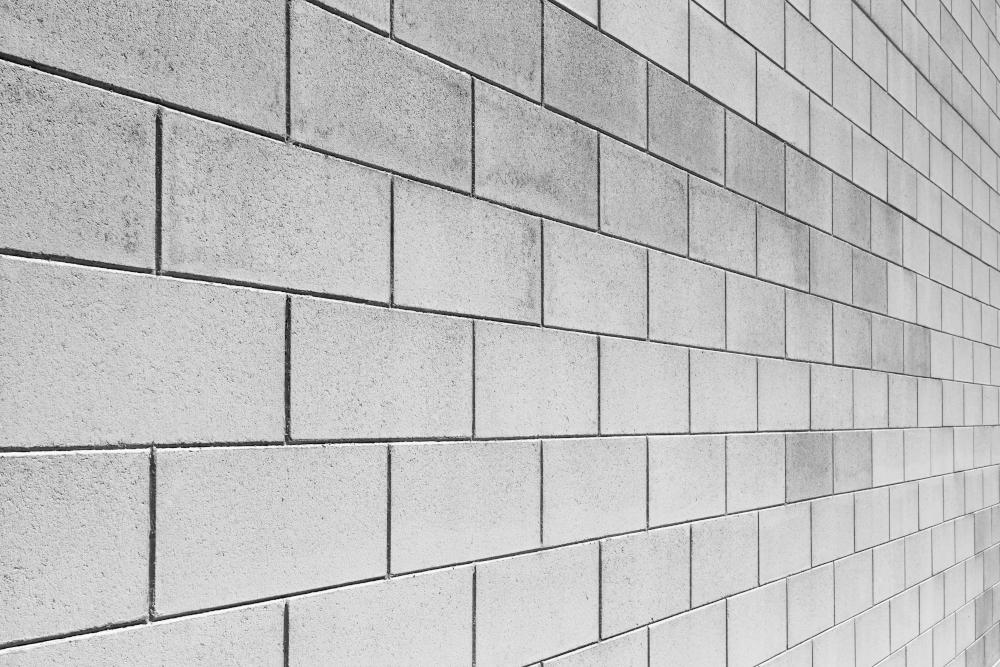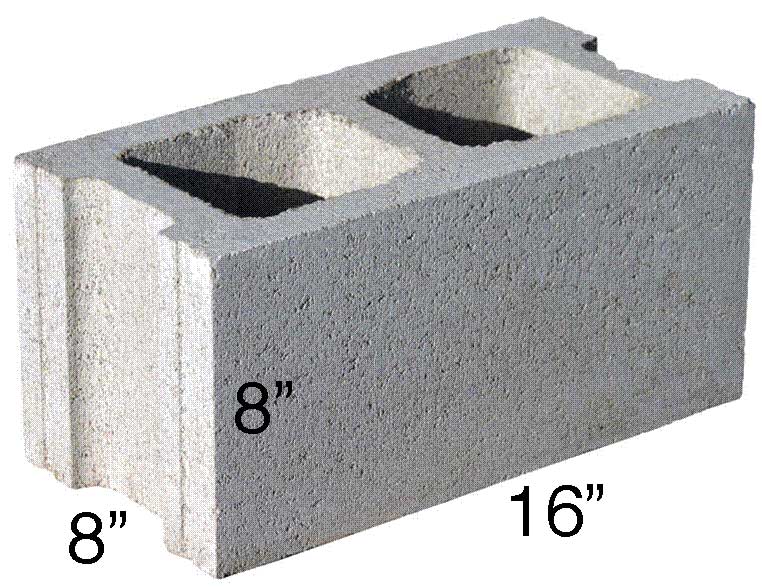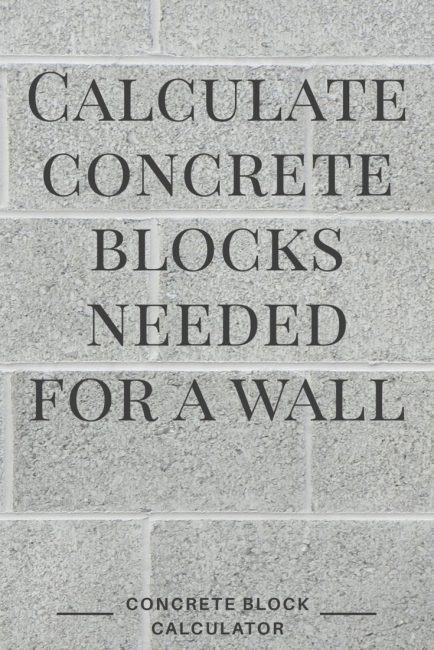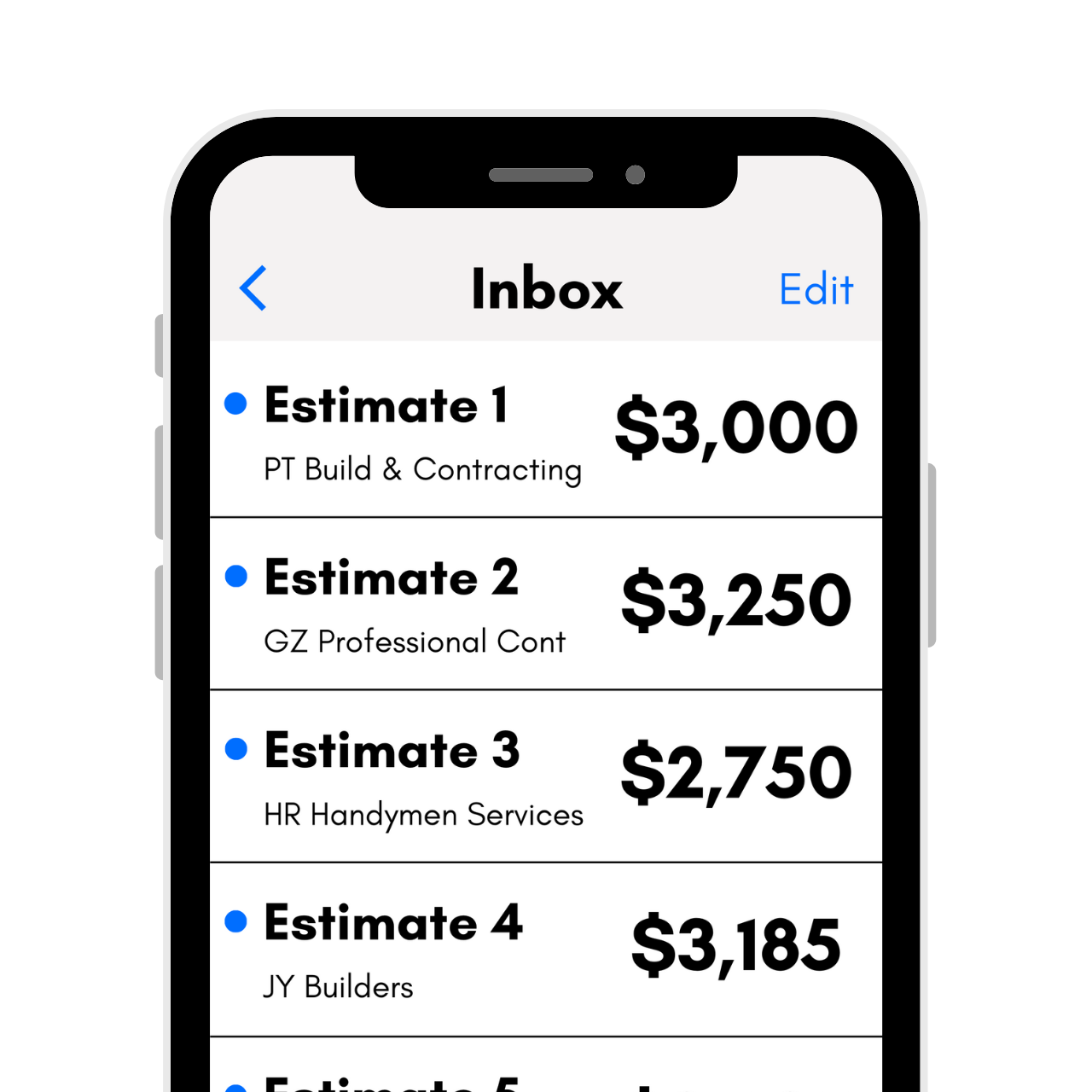Concrete Block Calculator
Calculate how many concrete blocks and bags of mortar are needed for your project by entering your wall dimensions and block size. Add the block price to get an estimated material price estimate.
On this page:
How Many Concrete Blocks Do You Need?
Concrete blocks are an affordable building material that can be used for many construction projects and are suited very well for construction walls for foundations or utility buildings.
Concrete blocks technically fall into two categories; solid blocks, which are commonly used for things like retaining walls, and CMUs, or concrete masonry units.
CMUs are hollow blocks that need to be filled with concrete during installation. Because the most common type of CMU is made of a mixture of cement and coal ash, these units are also frequently called cinder blocks.[1]
CMUs are available in many sizes, but the most common is 8″ deep x 8″ high x 16″ long.
A concrete block wall typically requires 1 1/8 blocks per square foot.

To determine how many blocks you’ll need for a project, enter the dimensions of your wall project into the calculator above, and it will figure out how many blocks you need. Alternatively, you can also follow the instructions below to calculate them manually.
Note: Retaining walls are often constructed from a different material than CMUs. If you’re building a retaining wall, then try our retaining wall calculator.
How to Calculate Concrete Blocks
There are several formulas to figure out how many concrete blocks are necessary for a wall project. Start by measuring the wall’s width and height in feet.
Step One: Find Wall Square Footage
Once you have the wall measurements, calculate the square footage of the wall by multiplying the width times the height.
wall sq ft = width × height
Step Two: Find Block Square Footage
Now you need to figure out the square footage of the block you are using. To do this, multiply the height and length of the block and divide by 144 – the number of square inches in a foot. The standard block size is 8″ high x 16″ long and has a square footage of 0.89.
block sq ft = 8 × 16 / 144 = 0.89 sq. ft.

Different size blocks will have different square footages; apply the formula above to find the solution. Check out our square footage calculator to determine the square footage of your block.
Step Three: Calculate Blocks
After you have found the square footage of both your wall and your block, determining the number of blocks you need is as simple as dividing the wall square footage by the block square footage.
blocks = wall sq ft / block sq ft
If you’re using a standard 8″ x 8″ x 16″ block, find the number of blocks needed by dividing the wall square footage by 0.89.
blocks = wall sq ft / 0.89
We recommend adding 5%-10% additional blocks to account for broken blocks or blocks that need to be cut for the edges.
Our calculator above may indicate a different quantity of blocks needed since it uses a more precise formula, accounting for partial blocks and cutoffs automatically.
How to Estimate Mortar for a Block Wall
Calculating the amount of mortar needed for the joints in a concrete block wall will vary depending on the mortar mix you use. Mortar is a mixture of cement and sand, usually with other additives.
If you are planning on mixing your mortar yourself, you will need a yield of 1:3 cement to sand mixture. On average, it takes about three bags of cement for every 100 blocks.
Divide the number of blocks being installed by 33.3 to calculate how many bags are needed. Once you have the number of bags, you will need one cubic yard of sand for every seven bags of cement.
You can also purchase pre-mixed bags of mortar, which can come in different formulations. Each formulation and brand may vary in how many blocks the mortar will bond.
Try our mortar calculator to calculate how many bags are needed.
How to Estimate Grout or Concrete Fill
CMUs are hollow and designed to be filled with concrete during installation. Estimating the concrete needed to fill the cells in concrete block involves getting more measurements from the blocks.
When looking at a block from the top down, the areas that run front to back on the block are called “webs”, while the areas that run side to side are called the “shell”. To calculate the fill volume, you will need the number of webs, their thickness, and the thickness of the shell.
Typical measurements for webs and shells may be around 1″ or 1.25″ depending on the size of the block.
The fastest way to get an accurate volume of the cells in the CMUs is to take the length and width of the block and subtract the shell and web measurements. For a block is 8″ x 8″ x 16″, this would look like:
Width: 8″ – 1″ (shell) – 1″ (shell) = 6″
Length: 16″ – 1″ (web) – 1″ (web) – 1″ (web) ÷ 2 cells = 6.5″
Height: 8″
The volume of the core would therefore be:
6″ × 6.5″ × 8″ = 312 cu in/block
Multiply this by the total number of blocks, and divide by 46,660 to get the total number of cubic yards needed.
Use our block fill calculator to estimate the fill volume.
Tools Needed to Install a Concrete Block Wall
If you’re installing a concrete block wall, you will need several tools to correctly do the job. Here is a small list of tools that are necessary to build a wall.
- Brick Trowel: This is used to lay an even bed of mortar when setting the blocks.
- Mason Line: Use mason line to ensure the wall is straight and level and the blocks are set at an even height.
- Level: Make sure you have a level on hand to verify that each block is straight and level with adjacent blocks.
- Jointer: Use the jointer to remove excess mortar between the blocks.
- Tape Measure: Use a tape measure to lay things out.
- Mixing Tub: Mix mortar in a mixing tub to keep your wheelbarrow clean.
As an Amazon Associate, we may earn commissions from qualifying purchases from Amazon. Learn more
Standard Concrete Block Sizes
You’ll need to know the size of the concrete block you’ll be using to determine how many blocks you need for your project. The most common sizes are 8″ high by 8″ wide and 8″ high by 16″ wide in varying thicknesses.
The block’s thickness is not critical to finding how many blocks you need, but it is essential when estimating how much mortar and other masonry material you need. The common thicknesses are 4″, 6″, 8″, 10″, 12″, and 14″.
Refer to the tables below for standard block sizes, including the nominal dimensions. The nominal size is the block’s actual size, while the size includes a 3/8″ mortar joint and is the size that should be used when estimating material.
The standard mortar joint should be 3/8″ thick for your wall.
2″ and 3″ CMU Block Dimensions
| Size D x H x L | Nominal D x H x L | Blocks per 100 ft2 |
|---|---|---|
| 2″ x 8″ x 16″ | 1 5⁄8” x 7 5⁄8” x 15 5⁄8“ | 113 |
| 3″ x 8″ x 16″ | 2 5⁄8” x 7 5⁄8” x 15 5⁄8“ | 113 |
4″ CMU Block Dimensions
| Size D x H x L | Nominal D x H x L | Blocks per 100 ft2 |
|---|---|---|
| 4″ x 8″ x 8″ | 3 5⁄8” x 7 5⁄8” x 7 5⁄8“ | 226 |
| 4″ x 8″ x 16″ | 3 5⁄8” x 7 5⁄8” x 15 5⁄8“ | 113 |
6″ CMU Block Dimensions
| Size D x H x L | Nominal D x H x L | Blocks per 100 ft2 |
|---|---|---|
| 6″ x 8″ x 8″ | 5 5⁄8” x 7 5⁄8” x 7 5⁄8“ | 226 |
| 6″ x 8″ x 16″ | 5 5⁄8” x 7 5⁄8” x 15 5⁄8“ | 113 |
8″ CMU Block Dimensions
| Size D x H x L | Nominal D x H x L | Blocks per 100 ft2 |
|---|---|---|
| 8″ x 8″ x 8″ | 7 5⁄8” x 7 5⁄8” x 7 5⁄8“ | 226 |
| 8″ x 8″ x 16″ | 7 5⁄8” x 7 5⁄8” x 15 5⁄8“ | 113 |
10″ CMU Block Dimensions
| Size D x H x L | Nominal D x H x L | Blocks per 100 ft2 |
|---|---|---|
| 10″ x 8″ x 8″ | 9 5⁄8” x 7 5⁄8” x 7 5⁄8“ | 226 |
| 10″ x 8″ x 16″ | 9 5⁄8” x 7 5⁄8” x 15 5⁄8“ | 113 |
12″ CMU Block Dimensions
| Size D x H x L | Nominal D x H x L | Blocks per 100 ft2 |
|---|---|---|
| 12″ x 8″ x 8″ | 11 5⁄8” x 7 5⁄8” x 7 5⁄8“ | 226 |
| 12″ x 8″ x 16″ | 11 5⁄8” x 7 5⁄8” x 15 5⁄8“ | 113 |
14″ CMU Block Dimensions
| Size D x H x L | Nominal D x H x L | Blocks per 100 ft2 |
|---|---|---|
| 14″ x 8″ x 8″ | 13 5⁄8” x 7 5⁄8” x 7 5⁄8“ | 226 |
| 14″ x 8″ x 16″ | 13 5⁄8” x 7 5⁄8” x 15 5⁄8“ | 113 |
How Much Does a Block Wall Cost?
A wall typically costs $10 – $15 to install; learn more about a wall project’s cost factors. We suggest getting several professional estimates to get the best labor cost and find the right company for your project.
Check out our concrete calculator to help with your other concrete projects.

References
- Wikipedia, Concrete Masonry Unit, https://en.wikipedia.org/wiki/Concrete_masonry_unit





